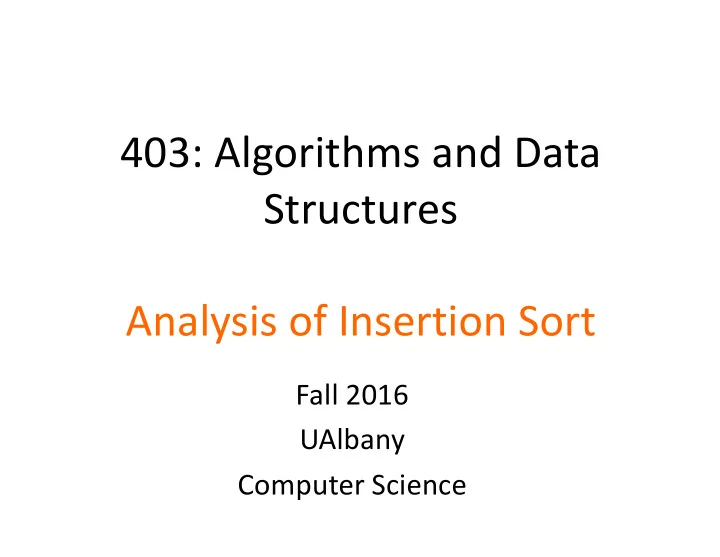

403: Algorithms and Data Structures Analysis of Insertion Sort Fall 2016 UAlbany Computer Science
Tune-in exercise • What is algorithm analysis? – Means to predict the resources needed for an algorithm execution. • What resources are we concerned with? – Running time and memory • Why do we need such resource prediction? – To be able to compare algorithms – To be able to provision resources for algorithm execution
Example of insertion sort on an instance The algorithm The input • Which is the algorithm? The output • Which is the input? • Which is the output? • What is the instance? <5,2,4,6,1,3>
Example of insertion sort on an instance Take a minute to think on your own of what is happening at each step.
Insertion sort (pseudo code) Input array is 1-based j indexes the whole array This step can be i indexes the sorted reached when i=0 or sequence if A[i]≤key. In both cases key is placed s.t. A[1…i] is sorted
Insertion sort -- analysis • Recall that each primitive operation takes constant time • Assume there are n numbers in the input c 1 c 2 c 3 • c 1 , c 2 , and c 3 are constants and do not depend on n
Insertion sort -- analysis • Assume there are n numbers in the input c 1 c 2 c 3 What is the time needed for the algorithm execution?
Insertion sort -- analysis • Assume there are n numbers in the input c 1 c 2 c 3 • While loop is executed at most j-1 times for a given j , so time spent in loop is at most (j-1)c 2 • Any iteration of the outer For loop takes at most c 1 +(j-1)c 2 + c 3 • The overall running time of insertion sort is = d 1 n 2 + d 2 n + d 3 𝒐 ∑ c 1 +(j-1)c 2 + c 3 𝒌$𝟑
Was our analysis too pessimistic? • We just performed a worst-case analysis of insertion sort, which gave us an upper bound of the running time. • Was our analysis too pessimistic? In other words, are there instances that will cause the algorithm to run with quadratic time in n? – The worst-case instance is a reverse-sorted sequence a 1 , a 2 , … , a n such that a 1 >a 2 > … >a n • Since worst-case sequence exists, we say that our analysis is “tight” and ”not pessimistic”.
Insertion sort growth rate • Consider insertion sort’s running time as the function d 1 n 2 + d 2 n + d 3 – The dominant part of this function is n 2 (i.e. as n becomes large, n 2 grows much faster than n) – Thus, the growth rate of the running time is determined by the n 2 term – We express this as O(n 2 ) (a.k.a. “big-oh” notation*) – We compare algorithms in terms of their running time * To be formally defined later
Algorithm comparison • Which algorithm is better? – We answer this question by comparing algorithms’ O() running times. • Example: Compare algorithm A and B. Which one is better? – Algorithm A: O(n 2 ) – Algorithm B: O(n log 2 (n)) • B is more efficient. • Intuitively n 2 grows faster • We might be wrong for small instances but when n is large B will be faster • Large sizes come about very often (Facebook has 100s of millions of users) By Cmglee - Own work, CC BY-SA 4.0, https://commons.wikimedia.org/w/index.php?curid=50321072
Announcements • Read through Chapters 1 and 2 in the book • Homework 1 posted, Due on Sep 7
Recommend
More recommend